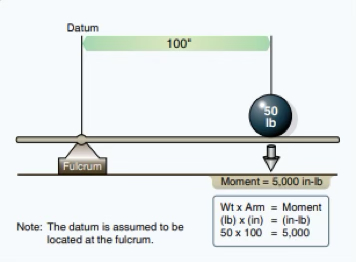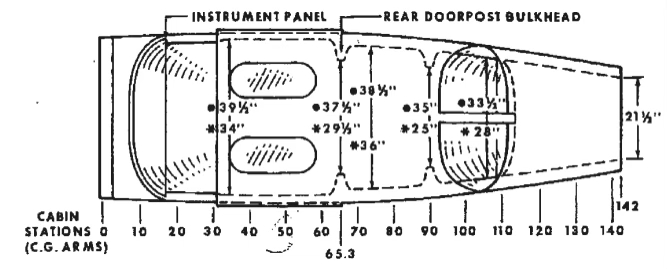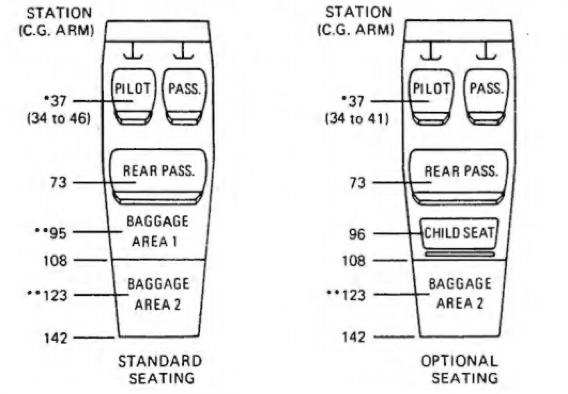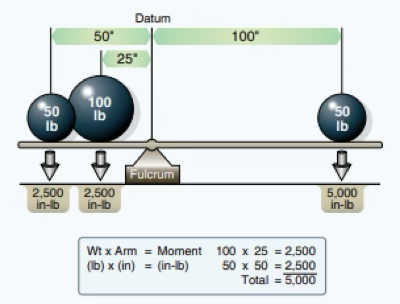
Airplanes are designed to be as safe as possible and perform well under a variety of circumstances, but this safety and performance is based on pilots remaining within the published limitations and performance envelopes. Pilots must understand the process and procedures for calculating the various factors which affect airplane performance, as well as how to consider airplane performance and limitations during flight planning.
The Importance of calculating Weight and Balance
It is quite easy to understand that the heavier an airplane is, the more force is required to make it fly, or to maneuver it. Airplanes are extremely sensitive to weight, and are designed to operate only in specific ranges of minimum and maximum weights.
Calculating weight and balance is essential in aviation because it directly impacts the safety, stability, and performance of an aircraft. Every flight relies on proper weight distribution and balance to ensure that the aircraft operates within its design limits. Here are the main reasons why calculating weight and balance is so important:
Safety and Stability
- Preventing Loss of Control: If the center of gravity (CG) is too far forward or aft, the aircraft may become uncontrollable, especially in critical phases like takeoff and landing.
- Avoiding Structural Overload: Exceeding the maximum takeoff or landing weight can put stress on the aircraft’s structure, increasing the risk of mechanical failure or structural damage.
- Managing Stall Risk: An improperly balanced aircraft, especially with a CG too far aft, can stall more easily. If the CG is too far forward, the aircraft may not be able to recover from a stall.
Performance and Takeoff/Landing Capability
- Shorter Takeoff and Landing Distances: An aircraft with the correct weight and balance can achieve optimal performance, allowing it to take off and land within the design runway limits.
- Climb and Descent Efficiency: Correct weight balance helps ensure that the aircraft can climb efficiently after takeoff and approach the runway at a manageable descent angle.
Controllability and Maneuverability
- Consistent Control: Proper weight and balance ensure that the aircraft responds predictably to pilot inputs, which is essential for smooth handling.
- Preventing Overly Responsive or Sluggish Flight: An aft CG makes an aircraft more responsive, which can make it challenging to control, while a forward CG can make it feel sluggish.
Efficiency and Fuel Economy
- Reduced Drag: Proper weight distribution, especially in larger aircraft, can reduce drag, leading to improved fuel efficiency and range.
- Optimized Engine Performance: With the CG in the optimal range, engines do not have to work harder to maintain the aircraft’s pitch, which conserves fuel.
Legal and Regulatory Compliance
- Required Calculations: For commercial flights, regulations from authorities like the FAA (Federal Aviation Administration) or EASA (European Union Aviation Safety Agency) mandate weight and balance checks to ensure all flights operate within safe parameters.
- Documentation: Pilots are required to document weight and balance calculations before each flight, making it a legal requirement as well as a safety measure.
Cargo and Passenger Safety
- Secure Loading: Ensuring that all cargo and passengers are within safe limits helps avoid shifts in weight that could throw the aircraft off balance during flight, especially in turbulence.
- Avoiding Shifts During Flight: If the CG is incorrectly calculated, shifting cargo or passenger movement could further destabilize the plane in mid-air, leading to dangerous situations.
Weight Considerations
- Takeoff and Landing Performance – Heavier airplanes require more runway to take off, and require more runway to land.
- Stall Speed – When flying at higher weights, the total load on the wing is higher, and the airplane must produce more lift to maintain straight and level flight. This requires a higher angle of attack for the same airspeed. Because airplanes always stall at the same angle of attack, and heavier weights increase angle of attack, it can be concluded that heavier aircraft stall at a higher airspeed.
- Load Factor – Airplane load factors (maximum and minimum structural loads) are computed only for allowable ranges of airplane weights. Exceeding these weights may cause structural failure in flight! This is especially true when encountering turbulence, etc.
- Maneuvering Speed – Likewise, flying at very light weights also affects performance, because it will require less flight control movement to produce the same forces. Recall that the wing will be flying at a lower angle of attack when the weight is lower, which means that the wing can produce more total lift before it stalls. This can result in the airplane exceeding the limit load factor at lower airspeeds!
Weight and Balance Terms
Weight: When we are talking about weight and balance – the “weight” can refer to a number of things. Such as how heavy is the airplane is overall (gross weight), or it can refer to an individual object is, such as passengers, cargo, fuel or airplane parts.
Basic Empty Weight: Weight of the airplane with all standard and optional equipment, plus any unusable fuel. Does not include weight of usable fuel, passengers, or cargo.
Maximum Gross Weight: Maximum weight allowable for the airplane.
Useful Load: Difference between Maximum Gross Weight and Basic Empty Weight. Load usable for fuel, passengers, and cargo.
Payload: Load available after fuel is loaded.
Datum: A given point on the airplane from which all relative distances are measured. For instance, the position of all objects in the plane can be specified in the number of inches from the tip of the propeller spinner, or any other location. The datum can be imagined as the fulcrum in a balance or scale.

Arm: The distance from the datum. The further that an object is from the datum, the longer the arm. Arm is usually expressed as inches aft of datum (positive arm numbers) or inches forward of datum (negative arm numbers). This is also sometimes called a station in some POHs.



Moment: In the ‘balance scale’ concept, moment simply describes the tendency of an object to rotate around the datum. A 50lb object 100 inches from the datum wants to rotate more than a 50lb object 50 inches from the datum. This is intuitively experienced with levers: the longer the lever, the less force must be applied to achieve the same result. When using a scale, a heavier object on one side can be balanced by lighter objects on the other, if those lighter objects are further away from the fulcrum. Moment is calculated by multiplying Weight x Arm, and is usually expressed in ‘inch pounds’.
Center of Gravity (CG): Once all individual weights in an aircraft are considered, the Center of Gravity (CG) represents a sort of ‘average position’ of the weights.
When balancing an object by a fingertip, objects balance on their center of gravity. When computing weight and balance for airplanes, the position of the CG is assumed to be some distance from the datum, represented as an arm, or inches aft of datum.
Center of Gravity (CG)
CG – The position of the Center of Gravity affects many aspects of airplane performance and stability:
- Longitudinal Stability and Stall Recovery – Longitudinal stability refers to an airplane’s stability in pitch.Most airplanes are stable in pitch, and have a gentle up-down pitch oscillation over time. The most important factor in longitudinal stability is the location of the center of gravity relative to the center of lift.
- Center of Gravity and Center of Lift – When conventionally designed airplanes fly, the center of gravity is always in front of the center of lift. You can think of the center of lift as a sort of pivot point in a seesaw. Because the horizontal stabilizer is far behind the center of lift, it produces downward force (essentially lift, but downward) to keep the nose of the airplane level. This downward force opposes the upward force of the main wing, requiring it to produce slightly more lift to compensate. Also, because any airfoil that produces lift also produces drag, the amount of drag caused by the horizontal stabilizer depends on the force it must produce.
- When the center of gravity is further forward, the horizontal stabilizer must produce more downward force to raise the nose, which adds to the loads placed on the Center of Lift pivot point (the main wing).
- Airplanes are designed so that they have a natural tendency to recover from a stall. A well-designed airplane’s Center of Gravity is always forward of the Center of Lift.
- This design causes a natural tendency for the airplane to nose down, reducing the angle of attack. To counteract this, the horizontal stabilizer and elevator surfaces of an airplane are designed to produce a downward force, which ‘holds up’ the heavier nose area by pivoting the airplane around the Center of Lift. When an airplane stalls, if the elevator pressure is relaxed, the Center of Gravity will fall naturally.
- As the Center of Gravity moves closer to the Center of Lift, the natural nose-down stall-recovery tendency is weakened, and it requires less downward force by the tail to move the nose up or down. In this configuration, relatively small movements of the elevator can cause large, rapid changes in pitch. When an airplane Center of Gravity is too close to the Center of Lift, or even behind it, a very dangerous situation exists where there is no natural tendency to recover from a stall. In fact, if the Center of Gravity is too far rearward (aft), the airplane may be uncontrollable in pitch and a stall may be unrecoverable! This situation is called longitudinal instability.
Stall Speed
Similar to the natural tendency for a forward CG to cause the airplane to recover from a stall, a forward CG requires the rear horizontal stabilizer to produce more downward force to keep the nose raised for level flight. This in turn adds more weight for the main wing to support, increasing its angle of attack, and therefore increasing stall speed.
Directional Stability
Directional stability is stability in yaw. Airplane yaw is largely controlled by the vertical tail surface, and to a lesser extent, the fuselage itself. Due to the large distance from the center of gravity, the tail surface is very effective at maintaining directional stability. When the CG moves rearwards, towards the tail, the tail surface is less effective and directional stability is reduced.
Methods of Weight and Balance Control
Pilots have a few ways to manage the weight and balance of an airplane.
- Moving or reducing passengers or cargo – If the weight is too much, the amount of passengers or cargo can be reduced. Similarly, if the issue is merely that of balance, it is possible that simply moving the passengers or cargo to another location can alleviate the problem.
- Adjusting fuel load – Airplanes often carry significant amounts of fuel, which can be reduced to give a higher payload (weight carrying capability for passengers and cargo).
- Ballast – If the issue is solely one of CG, it is often possible to add relatively small weights to baggage compartments to generate large changes in the CG, since baggage compartments are often far from the datum.
- Computing Weight and Balance – In order to determine the total weight and find the Center of Gravity for an airplane, the Gross Weight and CG location must be computed.
- How To Compute – Computing weight and balance is fairly simple:
- Step 1: Start with the Airplane’s Empty Weight and CG. This can be found in the POH, and represents the Gross Weight and CG location with no (usable) fuel, passengers, or cargo. See your Airplane POH Section 6 [Weight & Balance]
- Step 2: Add the weight of fuel, passengers, and cargo to the Airplane Empty Weight. This is the gross weight.
- Step 3: Multiply the weight of each item (fuel, each passenger and item of cargo) by the arm for their location. This provides the moment for each item. Compute the moment of the empty airplane by multiplying the Airplane Empty Weight by the empty CG. (Some W&B sheets already provide this) This is the empty moment.
- Step 4: Add each calculated moment to the empty moment to determine the total moment.
- Step 5: Divide the total moment by the gross weight. This provides the CG location, in terms of distance from the datum.
- How To Compute – Computing weight and balance is fairly simple:
- Check Flight Envelope – Use the POH to find where the computed gross weight and CG lie within the envelope. Depending on the POH, you may need to use total moment or CG (inches). If the intersection between the weight and CG does not lie within the envelope, the airplane is not within the allowable CG range and weight must be added, removed, or moved to alter the CG!
- Normal vs Utility Category – Note that many airplanes may be operated in the Utility Category at certain ranges of weight and CG. If the maneuvers being planned require the airplane to be operated in this category, be sure to ensure the weight and CG are within limits for that area of the flight envelope.
Weight and balance is a key factor in not only design but in the performance and stability of an aircraft under various operating conditions.
Aircraft balance about their Center of Gravity (C.G.), whose location determines aircraft characteristics
The position of the center of gravity is affected by the total and the distribution of weight throughout the aircraft.
Weight parameters ensure the wings and overall structure can support the aircraft throughout all flight envelopes.
Before every flight, pilots must determine the weight and balance to ensure the aircraft operates within manufacturer specifications
Weight and balance data is more than an exercise in determining where an aircraft’s C.G. will fall
It is a safety concern that has cost the lives of many pilots and their passengers